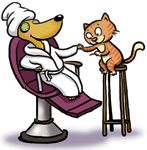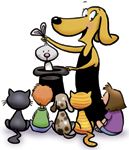5 ways to make clients feel welcome
It only takes a little extra effort to make pet owners feel special. The benefit: happy, loyal clients who appreciate your care.
A new client hands you a runny, grass-covered fecal sample in a plastic grocery bag. You offer him a friendly smile, a bottle of juice, and some hand sanitizer. The phone rings. It's Mrs. Anderson again. Could you move her appointment to 2:30? She's having a hard time getting Tuckleberry out from under the bed. "Why don't you try opening a can of tuna, Mrs. Anderson?" you suggest.
Your teenage kennel worker taps you on the shoulder. Her co-worker just barfed on the floor. (It must have been a parvo mess that did it!) Would you mind fetching Mr. Finkle's poodle from the boarding area while she cleans it up? You walk over to the new client, lend him some reading material, give his dog a pat, and tell him you'll be right back.
A little extra effort goes a long way toward helping clients feel recognized and welcomed. The five steps that follow will help you offer the highest quality service—and help clients feel at home in your practice.

1 Play the name game
Calling the client "ma'am" or "hey, you" just doesn't have the personal touch that lets clients know you care. Clients might not expect you to know their names, but imagine how good they'll feel if you do. And, it only takes a minute to look ahead in your appointment book so you know who's visiting today.

Don't forget to give pets a friendly, personal greeting, too. You might even include a quick pat or an ear scratch if the pet seems receptive. "We kiss, we hug, and we cuddle—unless we see teeth!" says Karen Sabatini, a Firstline Editorial Advisory Board member and a receptionist at Ardmore Animal Hospital in Ardmore, Pa.
Of course, you can't forget the basics: Make sure you check the pet's gender. You may undo the goodwill you earned if you greet Rambo with a friendly, "hey girl!" To avoid this blunder, team members at Windsor Veterinary Clinic P.C. in Windsor, Colo., mark female pets' charts with a pink dot and males' charts with a blue one. If you're a paperless practice, you may be able to set up your software to show a pink or blue background on the patient's record.
If your hospital is large enough, consider appointing a designated greeter to make sure each client gets a personal welcome. For example, Bowman Animal Hospital and Cat Clinic Inc. in Raleigh, N.C., employs a full-time greeter who offers everyone a warm welcome and helps new clients fill out forms, says Hospital Administrator Monica Dixon Perry.
2 Give new clients extra care
Clients may come up with some pretty strange ideas about the back areas of your hospital if you don't take the time to show them where you take their pets when you disappear on the other side of the exam room door. Sharon DeNayer, a board member and the practice manager at Windsor Veterinary Clinic, suggests giving new clients a tour. "I don't want clients to think that the back area of the hospital is a scary place," she says. "I want them to feel comfortable in any part of the clinic."

New clients also may have more questions, and they may forget to ask them in the exam room. That's why team members at Windsor Veterinary Clinic offer clients their business cards at the end of each visit. When they offer their card, they say, "We've gone over a lot today. If you think of any questions later, please give me a call." Regular clients will appreciate a card, too. It's a nice reminder that you're always available, even after the appointment ends.
3 Pamper your clients a bit
No one likes to wait. And if you don't know why you're waiting, it's easy to feel irritated and forgotten. That's why it's always better to explain delays to clients. "If you explain the situation, most people understand," says Rickee Miller, a veterinary assistant at Lockwillow Avenue Animal Hospital in Harrisburg, Pa.

If the delay will be longer than 15 minutes, offer to make another appointment or switch the appointment to another doctor. Bowman Animal Clinic even offers day hospitalization for clients on tight schedules.
To make the wait seem shorter, offer refreshments. You can simply offer a glass of water or stock an entire hospitality center with coffee, bottled water, and juice. And don't forget a water dish for pets.
You also might give clients reading materials, such as a clinic brochure or an educational pamphlet on FIV. Or, if you can, spend a few minutes chatting with pet owners—you'll be surprised by how quickly the time flies.
4 Entertain little clients, too
You'll never find a more impatient client than the 3-year-old who's missing his afternoon nap to sit in your waiting room with his cat, Baxter, and his frazzled mother. Just imagine the gratitude you'll earn if you can entertain this little fella for just a few minutes while mom tries to fill out the new patient form you passed her.

"When you entertain children, their parents can focus on the animal," DeNayer says. Windsor Veterinary Clinic offers children a doctor's kit and a stuffed animal that they can take with them into the exam room. A television with a VCR can also be a great distraction tool—simply pop in a cartoon, and you've bought clients a few extra minutes of peace while you explain why Baxter needs a dental prophy. Or you could stock a kid's corner in the reception room with a laundry basket full of toys or set up a Lego table to keep little fingers occupied.
Finally, don't forget to reward children for good behavior at the end of the visit. Dixon Perry stocks a drawer with such rewards as stickers, yo-yos, and sunglasses for well-behaved children.
5 Give extra comfort for euthanasias
Clients need extra care when they're facing the decision to say goodbye to a beloved pet. Use these simple steps to make this difficult situation easier.

- Schedule euthanasias for the end of the day. This approach gives you more time with clients. "It's important to give people time to say goodbye," Miller says. "Euthanasias aren't 15-minute appointments."
- Don't make these clients wait. Take them immediately to the exam room and notify the doctor.
- Offer to call family members. If clients need to notify someone else, ask whether they'd like you to make the call.
- Talk clients through the procedure so they know what to expect, and do what you can to make them feel comfortable with their decision. Sabatini tells clients, "It's like a final gift you can give to your pet."
- Let the pet sit on a blanket, furniture, lap, or anything soft in its last moments. Windsor Veterinary Clinic uses separate comfort rooms for euthanasias that feature rockers, love seats, dimmed lights, tissues, and soft music to create a comforting environment.
- Escort clients out the back door when they're ready to leave so they don't have to face a roomful of pets and clients.
- Finally, note the location of the procedure, and, if possible, don't take the client there again. When clients return with a new pet, they don't want to revisit a place of sadness, DeNayer says.
Take a "can-do" approach
When a client asks you for something you can't provide, respond by telling clients what you can do for them, not what you can't, say experts at businessknowhow.com. For example, instead of saying, "Dr. Smith can't see Fluffy this morning," say, "I can schedule an appointment for Fluffy with Dr. Smith at 5 p.m. today."
Ask the right questions
Sometimes it's hard to tell exactly what a client's asking for. That's why Impact Learning Systems recommends asking plenty of questions. Just remember to explain to clients that the questions will help you solve their problems so they don't feel quizzed.
E. Nora O'Donnell is a freelance writer in Evanston, Ill. Please send questions or comments to firstline@advanstar.com.